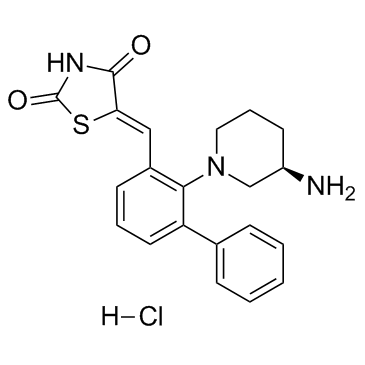AZD1208 hydrochloride
Modify Date: 2025-08-25 19:13:49

AZD1208 hydrochloride structure
|
Common Name | AZD1208 hydrochloride | ||
|---|---|---|---|---|
| CAS Number | 1621866-96-3 | Molecular Weight | 415.94 | |
| Density | N/A | Boiling Point | N/A | |
| Molecular Formula | C21H22ClN3O2S | Melting Point | N/A | |
| MSDS | N/A | Flash Point | N/A | |
Use of AZD1208 hydrochlorideAZD1208 hydrochloride is a novel, orally bioavailable, highly selective PIM kinases inhibitor. |
| Name | AZD1208 hydrochloride |
|---|
| Description | AZD1208 hydrochloride is a novel, orally bioavailable, highly selective PIM kinases inhibitor. |
|---|---|
| Related Catalog | |
| Target |
PIM[1] |
| In Vitro | AZD1208 hydrochloride shows good antiproliferative activity in a megakaryoblastic leukemia cell line, MOLM-16, with GI50 values less than 100 nM[1]. AZD1208 hydrochloride (10 μM) inhibits the growth of Ramos cells, and at 1 μM, strongly inhibits PIM kinases in all cells at 1 μM. AZD1208 hydrochloride induces apoptosis, and PIM2 knockdown is mainly associated with an alteration of the cell cycle[2]. The combination of AZD1208 hydrochloride and AZD2014 rapidly activates AMPKα, a negative regulator of translation machinery through mTORC1/2 signaling in AML cells; profoundly inhibits AKT and 4EBP1 activation; and suppresses polysome formation[3]. |
| Kinase Assay | The activity of purified human PIM-1, PIM-2 and PIM-3 enzymes on substrate FL-Ahx-Bad is determined using a mobility shift assay on a reader. The PIM-1 assay is performed in a 12 mL reaction containing 50 mM HEPES (pH 7.5), 1 mM DTT, 0.01% Tween 20, 50 mg/mL BSA, 10 mM MgCl2, 1.5 mM FL-Ahx-Bad peptide, 100 mM ATP, 2.5 nM PIM-1 and various amount of inhibitor. The reaction is quenched after 90 minute incubation at 25˚C with 5 mL of stop mix consisting of 100 mM HEPES, 121 mM EDTA, 0.8% Coating Reagent 3 and 0.01% Tween 20. The ATP and enzyme concentrations for the PIM-2 assay are 5 mM and 2.5 nM, respectively, while 50 mM of ATP and 0.33 nM of enzyme is used for PIM-3 assays. For high [ATP] screenings, 5 mM ATP is used with 0.67 nM enzyme for both PIM-1 and PIM-2 or 0.11 nM PIM-3. Fluorescence of phosphorylated and unphosphorylated substrate is detected and a ratiometric value is calculated to determine percent turnover. IC50 values are determined from dose-response data using software[1]. |
| Cell Assay | MOLM-16 cells, purchased from DSMZ and cultured in RPMI containing 10% fetal bovine serum (FBS) and 1% L-glutamine, are plated at 20,000 cells per well in 96 well plates overnight. Cells are treated for 72 hours with compound (including AZD1208 hydrochloride) or control vehicle (dimethyl sulfoxide) and cell viability is measured after the addition of Cell Titer-Blue for 4 hours at 37˚C and reading of fluorescence on a Tecan Infinite® 200. The GI50 is determined by calculating growth at each dose relative to vehicle treated cells and cell viability at the time of treatment[1]. |
| References |
| Molecular Formula | C21H22ClN3O2S |
|---|---|
| Molecular Weight | 415.94 |
| Storage condition | 2-8℃ |